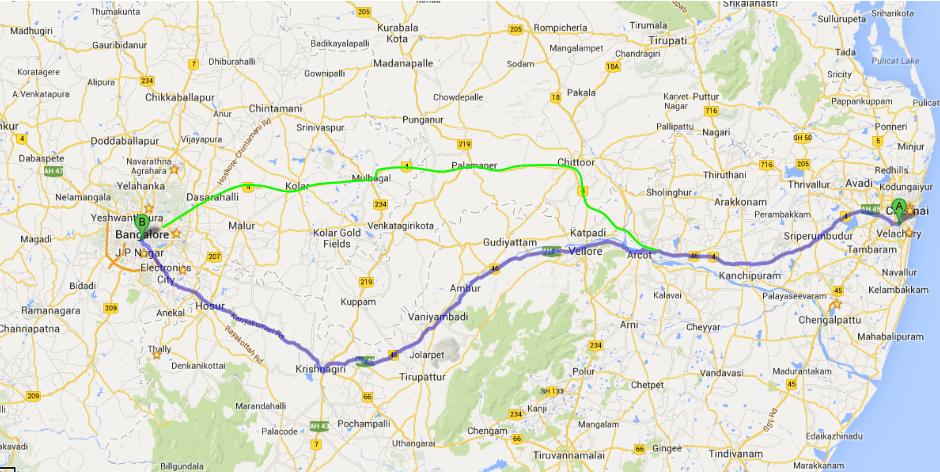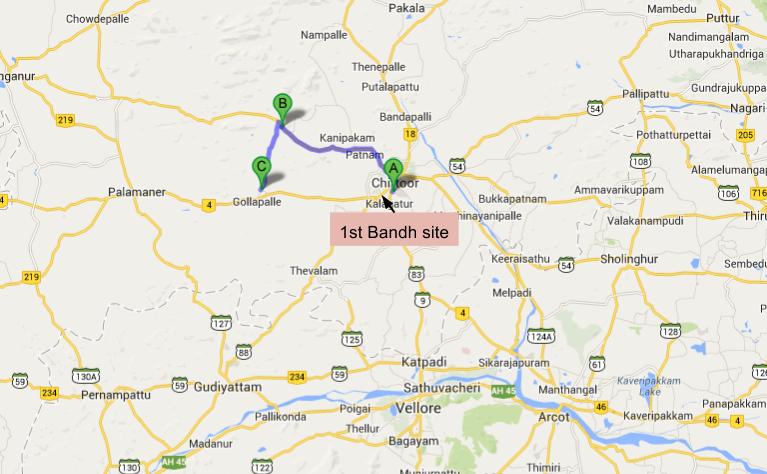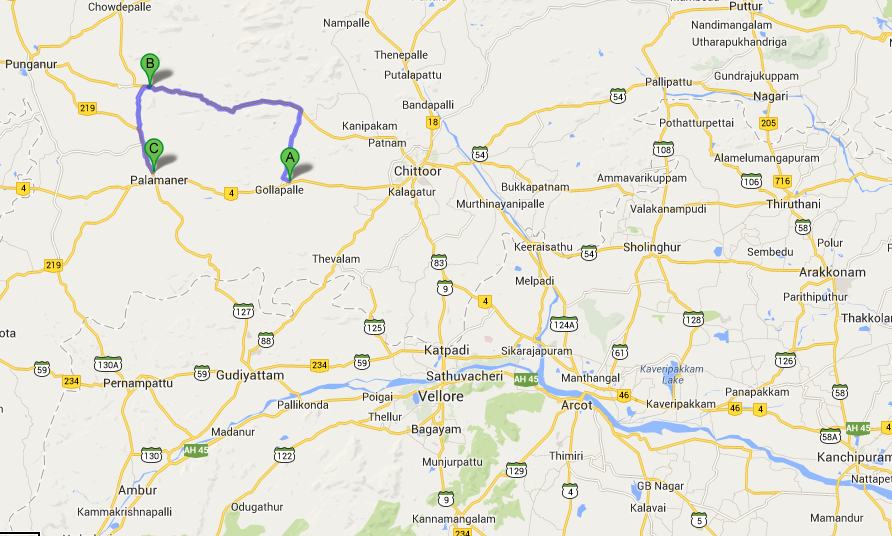There are no really bad ways and no really great ways to get from Chennai to Bangalore. Bus, car, train, even plane – all have their benefits and drawbacks. Faced with one client meeting at noon and another at 3pm and an open weekend ahead of me, I opted to leave in the morning and drive.
Any Indian will tell you with full certainty that it takes exactly 5 hours to drive to Bangalore. However, I have never actually experienced this in my life and am still not sure it is physically possible. (Though I now hear myself saying it to others as well.)
Here is my story. I marked my mistakes with a * and good ideas with a ^.
My original plan was to leave at 6 am, giving myself a good extra hour to reach. As I told my friends, they continually told me to prepone my departure time to avoid traffic, so I left at 5 am^.
Below is a map featuring the accepted way to go to Bangalore in purple, and the “old” way to go to Bangalore in green.
My first meeting was very near the green route, so I decided to have an adventure* and go that way.
I reached the split without any problems. I had downloaded an audio book from Audible^ and enjoyed how quickly the trip was going. The older road was considerably slower, but not too bad. In my home, I often like to take the smaller, slower roads just for the fun of it, so it was right up my alley.
However, about an hour into my detour, I met a line of cars beginning to form. They had stopped because a truck had parked diagonally across the road. There were a lot of men hanging around. There was one man under the truck “pretending” it was broken and he was fixing it by staring at it endlessly and lying on his back.
Any Indian will be able to tell you this is a bandh.
A bandh is an Indian strike. In my detour, I had crossed over into Andhra Pradesh which is in a new phase of 60-year-old disputes about whether there should be two states or one (see Telangana). As I got out of my car^, I asked what was going on, and they said it was the start of a 2-month-long bandh by this particular party. Great timing, I thought. I got back in the car*, took out my map*, and checked for an alternate route*.
Turns out there was a smaller parallel road just to the north. I could drive through the small town of Chittoor, get on that road for a while and then come drive back down to meet up with the bigger road again – no problem. After all, if you put a roadblock on one part of the road, there shouldn’t be a need to block it again later, right?* (Cue ominous music)
Driving through the city was a bit of a chore, but I made it through, took the parallel road for about 20 km, and then drove back down south another 12 km to meet up with my route. Whew, problem solved, right? About 100 meters from reaching the road I wanted, I found a second roadblock, this one a little more serious than the first as there were many men running around and yelling in a way that told me they were drunk already. I stayed in the car this time^ and turned around.
Back to the map*. My northern parallel road kept going, and there couldn’t be a third roadblock*. 12 km back up, and then another 26 km to the next turn-down, and then I would be home-free.
However, my parallel road started to turn from country road to village road*. It continued to shrink and I could tell I was getting farther and farther away from anywhere I should be.
About 20 km into the drive, I felt very nervous, but kept pressing on because the map said I was still good and I had nearly made this thing pay off. Then, a man I passed flagged me down and told me to pull over. As much as I wanted to ignore him* and force this route to work, I slowly pulled over and rolled down the window, knowing he had bad news for me. He politely told me I was about 3 km from entering a forest preserve, or “jungle” as he called it. He said there is a watchman there and they will not let me go through.
Now I felt defeated. Sheepishly, I turned the car around^ and began the nearly 50 km journey back to the original point where I started my detour. I had given up and was ready to accept the fact that I should have gone with the main route (the original purple one) all along.
However, the story doesn’t end there. In the time that I had left, there was a new roadblock in Chittoor set up which was blocking my path to get back to the main road. This time, I got out of the car and talked to the men there^. I asked them how I could get to Bangalore with all these roadblocks. They were nice guys and pointed to one road that was open. I told them that I knew there was another block along this road and I wouldn’t be able to get through^. The leader told me to simply tell them that I had a plane to catch.
I asked the leader to call ahead to the next roadblock and tell them to let me through^, took a picture of the guys to prove I met them^, and then had the leader write his name on my hand and the name of the leader at the next roadblock as my pass to get through.
I made it to the next roadblock and was able to find a very small stream of small cars weaving through the front of a store to get through, which the protestors didn’t seem to mind. I showed a man the name of the guy who was supposed to let me through, but he didn’t recognize the name. However, he also didn’t seem to care that I was slowly passing through the intersection and I ended up just driving away^.
I hit one more major roadblock on that route which involved me driving through a field, refusing to pay an opportunistic Rs. 10 toll charged by three eight-year-olds holding a big stick^, accidentally breaking said stick*, and then quickly driving away through the field^.
Unavoidably late for my noon meeting, I had to pull over and take the call while advising other drivers how to get through.
I finally reached Bangalore by 3pm, exhausted, hungry, and much, much wiser about driving in India.
Lessons Learned:
1.) No is never no; talk to people. There is always another way to get through something, even protesting Telegus. After talking with the men at the first site, I could have easily convinced them to let me go through (like I did the last time), but I decided to make my own way. That said, it was a good idea not to get out and talk to the apparently drunk men at the second roadblock.
2.) Mainstream is easier; makeshift doesn’t usually work. There was a set road that I should have taken. At the first sign of trouble, I should have gone back. At the second sign of trouble, I was dumb to keep going. Trying to invent your own solutions in India nearly always results in failure.
3.) Trust your gut before your map. My map helped me a lot and it was also a crutch I should have ditched when things got tough. As an American, I love maps and rely on them for all sorts of travel. In India, maps can be liars. Not in the sense of being incorrect geographically (there is a road that connects these two areas), but because that road is barely big enough for a cycle to cross and has a huge crater in it. When you are driving to a major city and you find yourself on a one lane road with goats, it’s time to find a new way.
4.) Always factor in extra time. I probably would have reached my first destination around 10:30 am without the detours, but I still think the advice I got to leave earlier was good.
5.) Have an adventure on your own time. Taking the more direct route would have been a lot more fun if I didn’t have a meeting that I was quickly becoming late for.
6.) Chaos Beats Logic. Logic told me there would not be another roadblock later on. Logic told me a straight line on the map meant a passable road. When you start using the word “should” or “can’t” a lot (This route should work; It can’t be that bad), it’s a bad sign.
More on #ChaosBeatsLogic, and Daily Living
Map images from Google Maps.












